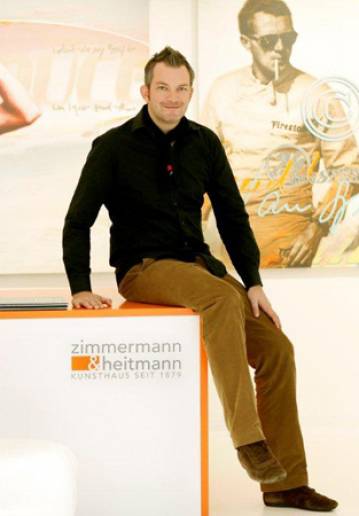

At first glance, these objects do not unveil their often disturbing content, but come across as beautifully shaped wooden sculptures. In doing so, he contextualises the objects in a completely new and often provocative way. He replaces important elements of the cuckoo clock, such as traditional carved decorations, with motifs dealing with themes of violence, pornography and death. Stefan Strumbel currently lives and works in Offenburg.Stefan Strumbel made a name for himself in particular by reinterpreting traditional cultural artifacts such as cuckoo clocks, anchors and crucifixes, and also by exaggerating elements of Street Art and Pop Art. Funky stripes beautifying the choir wall, LED light shining on speech bubbles and comic-book elements, all innovatively adorn the Catholic Church. The New York Times recently commissioned the artist to design the cover of the their magazine. Leading print media such as Der Spiegel and FAZ published articles about the 6 meters high Madonna dressed in traditional Black Forest clothing, enthroning with her infant Jesus above the entrance. The re-opening of the brand new designed Church on the Jwas recognized throughout all media platform. Even Pastor Thomas Braunstein praised Strumbel’s work as “a gift from heaven”. After initial skepticism towards the project, he soon owned the support of the whole town community. Strumbel approached the church with the idea of a completely modern intervention. With his transformed objects, Strumbel successfully creates an illusionary world, which reflects societies real maladies. In the German village of Goldscheuer, the artist reconstructed the interior of the built in 1962 Catholic Church Maria, help for the Christians.

He exposes the mechanism of a society that in its desire for status and the pursuit of consumerism surrenders to the constant attraction of the media. Strumbel raises significant identity questions with his work: How do I define Heimat? How do I perceive myself? How do I project myself to the outside world? How and through what do I define myself? With his art, Strumbel initiates a change in social values: Traditional ideals, clichéd notions of home and the reality of the individual are dissolved and transformed into an aesthetic that becomes an allegory of social status symbols. A German word that cannot be entirely translated one on one but loosely refers to heritage or home. Another key aspect of this work refers to the concept of Heimat. Strumbel, however, creates both, a unique artificial and artistic aesthetic with his usage of extreme exaggerations in regard to form content. With their colorful and bright surface, the artworks appear as light and shiny pieces of Pop Art. At first sight, these objects don’t reveal any of the disturbing content but appear as beautifully crafted wooden sculptures. By doing so, he puts the objects into a completely new and often provocative context, always pushing boundaries.

He replaces significant elements of the cuckoo’s clock, such as traditionally carved ornaments with motives that deal with the subjects of violence, pornography and death.

He made a name for himself by exaggerating traditional and cult artifacts such as cuckoo clocks, anchors and crucifixes and reincorporating elements of Street Art and Pop Art. Stefan Strumbel is a German artist, born on in Offenburg.


 0 kommentar(er)
0 kommentar(er)
